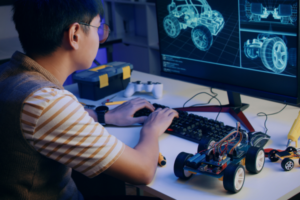In today’s fast-paced, technology-driven world, education goes far beyond memorizing facts and figures. To truly thrive in the modern era, children need to develop a diverse set of 21st-century skills — a blend of critical thinking, creativity, collaboration, communication, and digital literacy. These skills aren’t just buzzwords; they’re essential foundations for success in school, careers, and everyday life.
One powerful and engaging way to nurture these skills from an early age is through robotics toys. These toys go far beyond simple entertainment — they offer immersive, hands-on experiences that spark curiosity and teach kids how to think critically, solve problems, and adapt to challenges. Whether a child is building a robot from scratch or programming it to follow a set of commands, they’re actively learning by doing.
In this article, we’ll explore how robotics toys can support the development of 21st-century skills in kids of all ages. We’ll look at the core skills these toys help build, highlight the best robotics kits by age group, and share practical tips for using them at home or in the classroom. Let’s dive into the world of playful learning and future-ready kids!
What Are 21st-Century Skills?
Overview of the Core Categories
21st-century skills are the essential abilities every child needs to succeed in our increasingly complex and connected world. These skills are typically grouped into three main categories:
- Learning Skills – Often referred to as the “Four Cs,” these include:
- Critical Thinking: Analyzing information objectively and solving problems creatively.
- Creativity: Thinking outside the box and developing original ideas.
- Collaboration: Working effectively with others in both physical and virtual spaces.
- Communication: Expressing ideas clearly and confidently through various formats.
- Literacy Skills – These focus on how children understand and interact with the modern world:
- Information Literacy: Evaluating and using information effectively and ethically.
- Media Literacy: Understanding and interpreting media messages across platforms.
- Technology Literacy: Using digital tools efficiently and responsibly.
- Life Skills – These are practical skills that support personal and professional success:
- Initiative: Being self-motivated to explore, learn, and take on challenges.
- Flexibility: Adapting to change and staying open to new ideas.
- Leadership and Responsibility: Guiding others and owning one’s actions.
- Productivity: Managing time and completing tasks efficiently.
Why These Skills Are Essential
As automation, artificial intelligence, and digital tools reshape the workplace and society, rote learning and memorization are no longer enough. Today’s kids need to become adaptive, innovative thinkers who can collaborate across cultures, solve real-world problems, and navigate a constantly evolving tech landscape.
Whether children pursue careers in STEM, the arts, or entrepreneurship, 21st-century skills equip them to think independently, work well with others, and confidently face the unknown. That’s why educators and parents alike are turning to play-based tools—like robotics toys—that make these skills tangible, fun, and meaningful from an early age.
How Robotics Toys Build Core 21st-Century Skills
Robotics toys are more than just fun gadgets—they are powerful tools for developing the essential skills kids need to thrive in the 21st century. Through hands-on building, coding, and exploration, children naturally practice and strengthen a range of core competencies.
Critical Thinking and Problem-Solving Through Trial and Error
When a robot doesn’t move as expected or a program doesn’t run correctly, kids are challenged to analyze the issue, identify possible causes, and iterate on solutions. This trial-and-error process builds critical thinking and logical problem-solving in a real, tangible way. Kids learn that mistakes are part of the journey and that persistence leads to breakthroughs—just like in real-world innovation.
Collaboration in Multiplayer or Group Robotics Projects
Many robotics toys are designed for group use, whether in classrooms, coding clubs, or family settings. Kids often work together to assemble a robot, brainstorm programming strategies, or compete in friendly design challenges. These experiences foster teamwork, listening skills, and the ability to negotiate and compromise—all critical for collaboration in school, work, and life.
Communication Through Coding Instructions and Team Coordination
Programming a robot requires clear, structured thinking and the ability to translate ideas into a sequence of actions. Kids learn how to communicate logically through code while also explaining their process and decisions to peers or adults. Group projects require verbal communication and coordination, helping kids express themselves clearly and confidently.
Creativity in Designing, Building, and Programming Robots
Robotics blends engineering with art and imagination. From choosing materials and assembling components to designing behaviors through code, kids tap into their creative thinking to bring robots to life. They learn to innovate, experiment with new ideas, and approach problems from different angles—all while having fun.
Tech and Digital Literacy Through Robotics Play
In a world where technology is constantly evolving, digital literacy is no longer optional—it’s essential. Robotics toys offer a playful yet powerful way to introduce children to the principles of technology and computing in a hands-on, approachable format.
Understanding How Technology Works Through Hands-On Interaction
Robotics toys demystify tech by letting kids build, program, and interact with real devices. Rather than being passive users of screens, children become active creators, learning how hardware and software work together. They begin to understand components like sensors, motors, and circuits, laying a strong foundation for future exploration in electronics and engineering.
Developing Computational Thinking and Algorithmic Logic
Coding a robot requires kids to think like a computer—breaking tasks down into steps, using loops, making decisions with conditional statements, and debugging errors. These core elements of computational thinking help children develop structured problem-solving skills that go beyond coding and can be applied to math, science, and everyday life.
Bridging the Gap Between Digital Content and Physical Actions
One of the most engaging aspects of robotics toys is that they connect virtual code to real-world outcomes. Kids write instructions on a screen and see a robot move, speak, or light up in response. This cause-and-effect relationship reinforces their understanding of programming and gives them immediate feedback, which strengthens learning and keeps them motivated.
Life Skills Gained from Playing with Robotics Toys
Beyond developing technical and cognitive abilities, robotics toys also nurture essential life skills that help children become more capable, confident, and adaptable individuals. These toys challenge kids to think independently, manage their time, and bounce back from setbacks—all within the fun and creative world of play.
Building Resilience Through Debugging and Troubleshooting
When a robot doesn’t perform as expected, kids must figure out what went wrong—and fix it. This trial-and-error process teaches that mistakes are part of learning. Children discover how to analyze problems, stay persistent, and gradually improve their design or code. Over time, they develop grit and resilience, learning not to give up when things get tough.
Cultivating Initiative and Curiosity with Open-Ended Challenges
Many robotics toys are designed with open-ended tasks or even no set instructions, encouraging kids to explore freely. This format promotes self-motivation and a natural sense of curiosity, driving them to ask questions like “What happens if I change this?” or “Can I make it do something new?” These inquiries foster a lifelong love of learning and innovation.
Encouraging Independent Learning and Time Management
Working on robotics projects often requires planning, setting goals, and seeing tasks through to completion—whether it’s assembling a robot or programming it to complete a course. Kids begin to understand how to organize their time, work independently, and manage small milestones. These are crucial executive functioning skills that serve them well in school and beyond.
Best Robotics Toys for Developing 21st-Century Skills
Choosing the right robotics toys can make a huge difference in how effectively children develop 21st-century skills like critical thinking, collaboration, digital literacy, and self-management. Below is a curated list of top robotics toys that cater to different age groups and learning needs—all while making learning engaging and fun.
Toy 1: Botley 2.0 – Ideal for Ages 5–8, Key Skills Developed
Botley 2.0 is a screen-free coding robot perfect for younger children just beginning their STEM journey. Using a remote programmer, kids can code sequences, loops, and logic commands without needing a tablet or computer.
- Skills Developed: Sequencing, problem-solving, early coding logic
- Why It Stands Out: Easy to use, encourages independent learning, perfect for tactile learners
- Bonus: Comes with obstacle courses and hidden features for extended play
Toy 2: LEGO® Education SPIKE™ Prime – Features, STEM Focus, Learning Benefits
Designed for middle school students, the LEGO SPIKE Prime combines classic LEGO bricks with programmable motors and sensors using a Scratch-based or Python interface.
- Skills Developed: Engineering, creativity, computational thinking, teamwork
- STEM Focus: Coding, robotics, design thinking
- Why It Stands Out: Supports project-based learning and is often used in robotics competitions like FIRST LEGO League
Toy 3: Wonder Workshop Dash – Great for Group Play and Project-Based Learning
Dash the robot is highly interactive and designed for kids ages 6 and up. It can be programmed via tablet with block-based coding apps and works well in both classrooms and home settings.
- Skills Developed: Communication, collaboration, coding logic, perseverance
- Why It Stands Out: Excellent for group activities, responsive to voice commands, and grows with the child’s skill level
- Bonus: Dash has a wide range of accessories for expanded play
Toy 4: Makeblock mBot – Open-Ended Design to Foster Creativity and Innovation
The mBot is a build-it-yourself robot kit suitable for kids ages 8 and older. It introduces kids to both electronics and programming using block-based or Arduino/C++ code.
- Skills Developed: Creativity, initiative, digital literacy, design thinking
- Why It Stands Out: Modular design encourages tinkering and real-world application
- STEM Focus: Robotics, electronics, physical computing
Tips for Maximizing Skill Development Through Robotics Play
Robotics toys are powerful learning tools—but their true potential shines when they’re used intentionally. Whether at home or in the classroom, these tips will help you create a rich, supportive environment that fosters 21st-century skill development through robotics play.
Create a Structured Play Environment with Room for Exploration
Set up a dedicated space where children can freely build, test, and revise their creations. This space should be stocked with essential materials (robot kits, markers, rulers, notebooks) and offer a calm, organized setting that encourages both focus and creativity. A balance between structure (like scheduled time or activity prompts) and free exploration helps kids feel safe to experiment.
Integrate Robotics with Subjects Like Math, Science, and Art
Robotics isn’t limited to tech classes—it’s a natural bridge to other subjects:
- Math: Use robots to measure distances, angles, and calculate movement.
- Science: Explore physics concepts like force, friction, or circuits.
- Art: Design robot costumes, plan visual presentations, or animate movement in creative storytelling.
This cross-curricular approach reinforces learning by showing real-world connections.
Use Project-Based Learning to Give Purpose and Direction
Rather than isolated tasks, give kids challenges or real-world problems to solve with their robotics kits. For example:
- Build a robot to navigate a maze.
- Program a robot to deliver a message.
- Create a story and code the robot to act it out.
These kinds of goal-oriented projects promote problem-solving, teamwork, and perseverance—essential 21st-century skills.
Encourage Reflection: “What Did You Learn?” or “What Would You Do Differently?”
After each session, ask open-ended questions that spark metacognition—thinking about their thinking. Encourage kids to:
- Reflect on what worked or didn’t.
- Celebrate mistakes as part of learning.
- Identify strategies they might try next time.
This practice builds a growth mindset, helping children become confident learners who embrace challenges.
Overcoming Barriers to Robotics Play
While robotics toys offer exciting opportunities for learning and development, some families and educators may face barriers to fully embracing them. Fortunately, there are practical ways to make robotics play accessible, inclusive, and empowering for everyone.
Addressing Cost with Budget-Friendly or DIY Options
Robotics kits can be pricey—but learning doesn’t have to be. Consider these cost-effective alternatives:
- Budget kits like Ozobot Bit, Code & Go Mouse, or Sphero Mini offer great learning experiences without breaking the bank.
- DIY robotics using everyday materials (cardboard, straws, motors) teaches basic engineering and creativity.
- Community resources such as maker spaces, local libraries, or STEM clubs often provide free or low-cost access to robotics tools.
There are also free coding platforms like Scratch, Tynker, and Code.org that complement robotics play with interactive challenges and activities.
Supporting Parents and Educators with Limited Tech Knowledge
You don’t need to be a tech expert to guide kids in robotics! In fact, learning alongside them can be a powerful experience. Here’s how to get started:
- Choose beginner-friendly kits with clear instructions, visual coding apps, and online tutorials.
- Look for educator guides or parent support forums provided by toy manufacturers or educational communities.
- Focus on facilitation, not instruction—encourage curiosity, ask questions, and explore solutions together.
Adopting a co-learning mindset turns robotics time into an opportunity for both children and adults to grow.
Ensuring Inclusivity for Kids of All Learning Styles and Abilities
Every child deserves the chance to explore and thrive through robotics play. To foster inclusivity:
- Offer multiple modes of engagement—visual, tactile, verbal, or kinesthetic.
- Choose kits designed with universal design principles and accessible interfaces (e.g., larger buttons, audio instructions, or color-coded blocks).
- Use collaborative activities to encourage social learning and peer support.
- Celebrate diverse ways of thinking and solving problems—there’s no single “right” path in robotics!
Creating a safe, welcoming, and adaptive environment helps all learners feel confident and capable.
Recap of How Robotics Toys Naturally Build 21st-Century Skills
Robotics toys are far more than just entertainment—they’re powerful tools that cultivate critical thinking, creativity, collaboration, and tech literacy in a playful, hands-on way. Through building, coding, problem-solving, and exploration, kids naturally develop many of the essential 21st-century skills that will prepare them for future academic and career success.
Encouragement to Explore Robotics as a Future-Ready Investment
Whether you’re a parent, educator, or caregiver, investing in robotics toys means investing in your child’s growth, confidence, and curiosity. You don’t need a high-tech background or a big budget—what matters most is creating an environment where exploration is encouraged and mistakes are part of the process. With the right tools and support, robotics can empower children to become creative problem-solvers and lifelong learners.
Invitation to Share Favorite Robotics Toys or Experiences in the Comments
We’d love to hear from you!
What robotics toys have sparked your child’s imagination?
Have you seen growth in their skills through play?
Share your favorite robotics kits, success stories, or tips in the comments below—your experience could inspire other families and educators on their robotics journey!

 How Robotics Toys Develop 21st-Century Skills
How Robotics Toys Develop 21st-Century Skills


 Coding Toys for Kids: Bridging Theory and Practice in STEM Education
Coding Toys for Kids: Bridging Theory and Practice in STEM Education
 The Best Programmable Robots for Kids and Teens in 2025
The Best Programmable Robots for Kids and Teens in 2025
 The 5 Coolest Robotics Kits for Kids to Build and Code at Home
The 5 Coolest Robotics Kits for Kids to Build and Code at Home